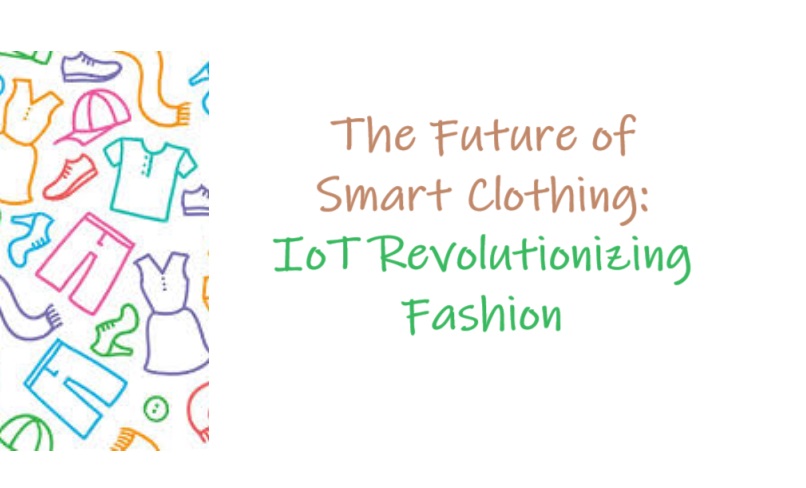Introduction
In recent years, the world of fashion has witnessed a remarkable transformation with the emergence of smart clothing. Enabled by the Internet of Things (IoT), these innovative garments have the potential to revolutionize the way we dress and interact with our clothing. From health monitoring to adaptive climate control, smart clothing offers a plethora of exciting possibilities for the future of fashion.
The Basics of Smart Clothing
Smart clothing, also known as e-textiles or electronic textiles, refers to garments that incorporate advanced technologies and sensors to enhance functionality and provide a seamless integration of technology into our daily lives. These garments are designed to be comfortable, stylish, and functional while also offering a range of smart features.
One of the key components of smart clothing is the integration of sensors. These sensors can monitor various aspects of our body, such as heart rate, body temperature, and movement. The data collected by these sensors can then be transmitted to a smartphone or other connected devices for analysis and tracking.
Smart clothing also often includes embedded microcontrollers or miniaturized computers that enable the garment to process and respond to the data collected by the sensors. This allows for real-time monitoring and feedback, making smart clothing a valuable tool for health and wellness.
Health Monitoring
One of the most promising aspects of smart clothing is its potential for health monitoring. With the ability to monitor vital signs such as heart rate, respiration, and even sleep patterns, smart clothing has the potential to revolutionize the way we approach healthcare and wellness.
Imagine a world where your clothing can detect irregularities in your heart rate and alert you to seek medical attention before a serious issue arises. Smart clothing can also provide valuable data to healthcare professionals, enabling them to make more accurate diagnoses and personalized treatment plans.
Furthermore, smart clothing can also be used to monitor physical activity and provide real-time feedback on performance, helping individuals optimize their workouts and prevent injuries. This integration of technology and fashion has the potential to empower individuals to take control of their health and well-being like never before.
Adaptive Climate Control
Another exciting feature of smart clothing is adaptive climate control. Traditional clothing is often limited in its ability to adapt to changing weather conditions, leaving us either too hot or too cold. Smart clothing, on the other hand, can use sensors to detect changes in temperature and adjust its properties accordingly.
For example, imagine a jacket that automatically adjusts its insulation based on the surrounding temperature. As the temperature drops, the jacket provides additional warmth, and as it rises, the jacket becomes more breathable. This level of adaptability ensures optimal comfort in any weather conditions.
Adaptive climate control in smart clothing can also help reduce energy consumption by eliminating the need for excessive heating or cooling. By providing personalized comfort, smart clothing has the potential to make a significant impact on energy efficiency and sustainability.
Personalized Style and Functionality
Smart clothing offers a groundbreaking fusion of fashion and technology, empowering individuals with personalized style and unparalleled functionality. Imagine garments that not only adapt to your body’s needs but also morph in color and design at your command. Whether expressing your mood, responding to environmental cues, or simply keeping up with the latest trends, these intelligent fabrics redefine the very essence of self-expression, offering a dynamic and customizable fashion experience like never before.
Challenges and Concerns:
Despite the promising advancements, the integration of IoT in smart clothing poses significant challenges and concerns. Privacy emerges as a primary apprehension, as the collection of personal health and lifestyle data raises questions about user consent and data security. Additionally, the practical implementation on a mass scale faces obstacles related to manufacturing costs, scalability, and compatibility with diverse body types. Striking a balance between innovation and addressing these challenges is crucial for the widespread acceptance and success of smart clothing in the ever-evolving landscape of wearable technology.
Industry Applications
The impact of smart clothing extends far beyond individual consumers, finding valuable applications across diverse industries. In sports, these intelligent garments can enhance athletic performance by monitoring vital signs and providing real-time feedback. The military can benefit from smart uniforms that offer advanced communication capabilities and health monitoring for soldiers. Entertainment industries may explore interactive experiences where costumes change in sync with narratives. As smart clothing continues to evolve, its potential applications in various sectors underscore its versatility and transformative influence on how we live, work, and engage with technology.
Future Trends and Innovations
Looking forward, smart clothing is gearing up for some cool changes. Imagine clothes that play well with augmented reality, making your experience more fun and interactive. There’s also a push towards eco-friendly fashion using sustainable materials, keeping the planet in mind. Fashion designers teaming up with tech wizards could give us clothes that not only look good but also do smart things. So, the future of smart clothing seems like it’s going to be a blend of style and cutting-edge tech, making everyday wear a bit more exciting!
Recommended: Smart Dust: Microscopic Marvels Transforming the IoT Landscape
Conclusion
The future of smart clothing is incredibly promising. With the IoT revolutionizing fashion, we can expect to see a wide range of innovative garments that enhance our lives in ways we never thought possible. From health monitoring to adaptive climate control, smart clothing has the potential to transform the way we dress and interact with our clothing. As technology continues to advance, we can look forward to a future where our clothing becomes an integral part of our connected lives.

